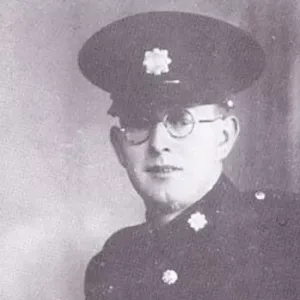
Eoghan Mór Ó Domhnaill
Photos by Owenie Mór Dhonnchaidh Sheáinín from a book by. Conall. (1998) The Legends of Our Ancestors. Cló Cheann Dubhrann, Rann na Mónadh, Athnacor, Donegal.
This writer was called Ownie Mór ’or Eoghan Dhonnchaidh by the people of his area. He was born in Rann na Feirste on 14 April 1908. His parents had nine other children and Eoghan was the eighth. His mother was Biddy Ní Bhaoill (Bidí Eoghainín). His father, Donnchadh (Donnchadh Padaí Sheáinín), was a farmer but also a carpenter. The 1901 Census was as follows: Denis O’Donnell (36), farmer and joiner (‘joiner’); his wife Bridget (27); Patrick (8); John (6); Dan (4); James (2); Barney [Brains] (month). The 1911 form is filled out as follows: Denis (49); Bridget (40); Patrick (18), carpenter; John (17), carpenter; Dan (14); James (12); Brian (10); Kate (8); Denis (6); Owen (4); Condy (one month old). There were two others born later, Josie and Peter. The couple was said to have been married for 19 years, and the nine children born to them were alive. Everyone listed in 1901 and 1911 spoke Irish and English.
He tells the story of his youth in The Days That Were, 1953 (new 1967 edition). Máirín Nic Eoin says in An litríocht régáil, 1982 about that book: Among all the books that describe the youth of the authors, there is probably no book in which the attitude of the child is as clear as it is in Na latha a bhí, by Eoghan Ó Domhnaill ’. He spent some time in school at the Christian Brothers in Dundalk and was appointed a member of the Garda Síochána on 21 February 1935 and was based in Sligo for a time. He used to teach Irish to adults all the time. His life was unsatisfactory and he left the force on 14 August 1935 after spending 174 days at Garda Headquarters in the Phoenix Park. . It is thought that Seosamh Mac Grianna advised him to do so. He may also have thought he could exploit writing
The Derry Journal 12 July 1966 states that he spent 13 years teaching Irish in Connacht. He certainly spent time in Ballyshannon. His first work was: An Chraobh Seilín: a play about the birth of our Savior. Written by Cathal Ó Beirn in English, 1935. Scéal Hiúdaí Sheáinín, 1940 is a material he wrote down from Hiúdaí Sheáinín Ó Domhnaill, his father’s uncle. Proinsias Ó Conluain says of that book (Scríbhneoireacht na gConallach, 1990 edited by Nollaig Mac Congáil): ‘… seriously, it is not quite an autobiography but a collection of folklore and folklore’. He spent some years teaching in Coláiste Bhríde, Rann na Feirste. He died on 30 June 1966 and is buried in Anagaire. He never married. He was a well – known Irish footballer during his youth; He is a talented singer and storyteller who has often broadcast on Radio Éireann. A writer who is mentioned as his occupation when probate was granted to his brother Peter. Although he earned little from writing during his lifetime, after his death The Days That Were (school edition, 1968) was placed on the Intermediate Certificate course and thousands of copies were sold.
Diarmuid Breathnach
Máire Ní Mhurchú
Full information above is available at www.ainm.ie
